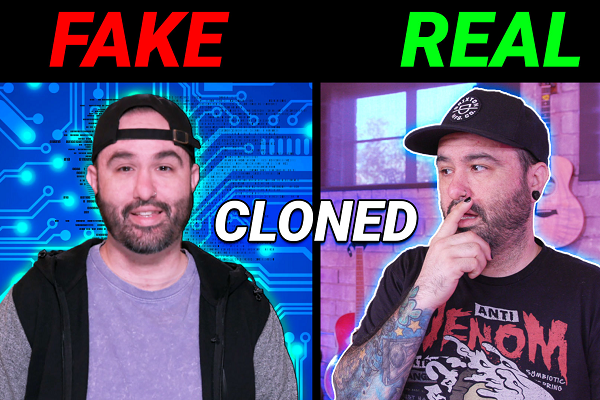Hour One Builds Virtual Clone of YouTube Tech Reviewer Dom Esposito
Popular YouTube tech review expert Dom Esposito’s latest video doubles down on his usual videos by showcasing his digital double, courtesy of virtual human startup Hour One. The AI-powered synthetic clone mimics Esposito’s body movements and facial expressions and joins Hour One’s catalog for hire by companies who want to hire his virtual self to star in commercial and industrial videos.
Hour One AI
“I reached out to Hour One because I was interested, and it turned into me going through the process of making the avatar. The process itself was very easy but also very hard,” Esposito told Voicebot in an interview. “I have the [hardware] equipment already, so we were able to set up remotely. As far as the actual capturing of what would eventually become my AI clone, that was a little more difficult. I had to hold my arms completely still and talk for two to three minutes at a time, then do the same thing while moving my head and then talk while being completely still. That was the hardest part for me. As someone who creates content, I’m used to making hand gestures and [facial] signals.”
Hour One’s AI builds virtual human models after analyzing enough video recordings of someone moving and speaking to mimic them. The avatar model can then be matched to an audio file to give a speech and move like the original human. Companies use Hour One avatars for receptionists, sales, HR, and language teachers, among other roles. The company recently debuted a tool for creating synthetic news reports with AI anchors from a text script. The company has a text-to-speech (TTS) engine that can also mimic the voice of the person behind the avatar, including translating it to different languages, but Esposito’s model is purely visual for now. With his AI self in Hour One’s catalog, Esposito will get paid when it is chosen for use by an Hour One client.
“I was pretty blown away. It’s weird to see; I almost want to say a ‘soulless’ version of yourself that is autonomous in a way. It looks like their other avatars,” Esposito said. “Being on the platform is just an eerie and exciting feeling. My long-term goal is to one day have an avatar and voice that lives on the internet and can communicate with people after I’m gone, like in a Zoom call or Facetime.”
It wasn’t a heavy time investment either, as Hour One created his avatar from two or three hours of footage and shared the completed project in just a few weeks. Esposito has his own plans for the avatar. He explained that he plans to test it in his videos on YouTube and Instagram Reels, particularly when most of the screen is visuals, and he would be on just a fraction of the screen. This isn’t Hour One’s first experiment with an influencer. YouTuber Taryn Southern and Hour One created her virtual clone more than a year ago to test the technology. And the company even powered the digital Boss Baby deployed on Cameo. Southern has already suggested the two clones get together in a future video. Creative endeavors may well be a significant part of how Hour One and other digital clone labs become mainstream.
Our two clones should collab 🤖 + 🤖 = ☺️https://t.co/GWyYjX959C
— Taryn Southern (@TarynSouthern) September 6, 2022
“When I published my video, one of my creator friends said if they could do this and not have to be on camera all the time, that would be fantastic,” Esposito said. “I think the creator space is somewhere this could be used a lot. I’m all for making my life easier. Time is the one thing you can never get back. I’m excited for all the opportunities this brings, not only with the avatar but with everything in the future virtual beings will bring.
Follow @voicebotai Follow @erichschwartz
Hour One Debuts Synthetic Video News With Virtual Human News Anchors
How YouTube Star Taryn Southern Produced A Virtual Human Clone of Herself
Cameo Hires Boss Baby’s Virtual Clone and Synthetic Alec Baldwin Voice to Record Personal Messages









